Cohort Study | Medical Science Optional Notes for UPSC PDF Download
Introduction
A cohort is a collection of individuals who possess a shared characteristic or have undergone a common experience during a specified time frame
Examples:
- Birth cohort - A set of individuals born on the same day of a year or within the same birth year.
- Exposure cohort - A group of children who received the OPV vaccination on the same day.
- Marriage cohort - A collection of couples who got married on the same day or month of a particular year.
Definition of Cohort study (Health Research methodology - WHO bulletin)
It is a type of observational analytical study design where a cohort of individuals is identified based on the presence or absence of exposure to a suspected risk factor for a disease. Subsequently, these individuals are followed over a period of time to assess the occurrence of the outcome.
Synonyms
- Prospective study
- Forward looking study
- Exposure to outcome study
- Cause to effect study
- Risk factor to disease study
- Incidence study
- Follow up study
Basic principles of Cohort study
- It commences with individuals who are currently free of the disease, with the outcome yet to occur.
- The study population is categorized into exposed and non-exposed groups for comparison.
- Follow-up is conducted to monitor the development of the outcome.
Indications for Cohort Studies:
- When there is strong evidence of a link between exposure and disease.
- Particularly suitable when exposure is infrequent but the incidence of the disease is higher among the exposed group.
- Preferable when attrition (loss of follow-up) in the study population can be minimized.
- Requires ample financial resources.
Types of Cohort Studies
Prospective (Concurrent):
Commences with exposure, and the study progresses forward in time to ascertain the outcome.
Examples:
- Framingham Heart Study
- Doll and Hill Study (Smoking vs. lung cancer)
- Study of Oral Contraceptives and Health by the Royal College of General Practitioners
Retrospective (Historical/Non-concurrent):
Exposure details are gathered from past records, and the outcome is determined during the study.
Examples:
- Boston Hospital 1978 Study - Effects of electronic fetal monitoring during labor on neonatal death
- Study of the role of Arsenic in human carcinogenesis
- Study of lung cancer in uranium miners
- Polyvinyl chloride exposure and the risk of developing angiosarcoma of the liver
Combined (Ambidirectional):
Exposure details are obtained from past records, and the outcome is determined during the study, with subsequent follow-up to observe changes in the outcome.
Example:
- Court Brown and Doll Study (Effect of Radiation)
Design/Components of a Cohort Study:
- Identification of study participants
- Collection of exposure data
- Establishment of a comparison group
- Follow-up
- Data analysis
Selection of study subjects
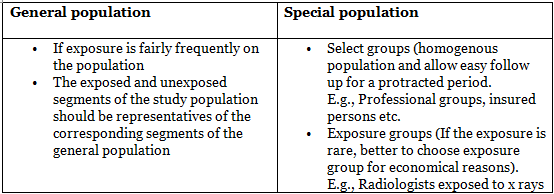
Collecting exposure data:
- Personal interviews/Mailed surveys
- Record reviews
- Physical examinations
- Environmental surveys
The information obtained should facilitate the classification of cohort members into:
(a) Whether they were exposed or not exposed
(b) In the case of exposure, classification based on the level or degree of exposure.
Selection of Comparison Groups
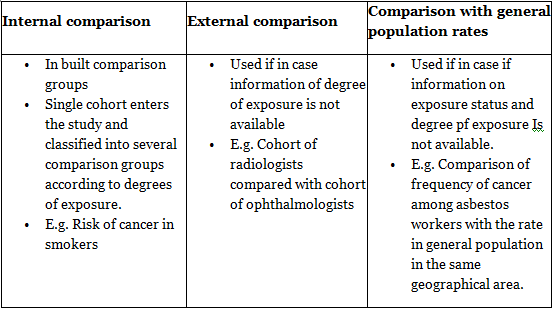
Follow-Up:
- The most crucial phase of a cohort study.
- Involves periodic medical examinations, scrutiny of physician and hospital records, routine monitoring of death records, mailed questionnaires, telephone calls, etc.
- Potential for attrition bias due to loss of follow-up.
- It is advisable to achieve close to a 95% follow-up rate.
Analysis:
The strength of the association is assessed through:
- Relative Risk (RR)
- Attributable Risk (AR)
- Population Attributable Risk (PAR)


- Incidence rates among the exposed: 70/7000 = 10 per 1000.
- Incidence rates among non-smokers: 3/3000 = 1 per 1000.
- Relative risk = 10/1 = 10 (indicating that smokers are 10 times more likely to develop lung cancer than non-smokers).
- Attributable risk = (10 - 1) / 10 * 100 = 90 percent (meaning 90 percent of lung cancer cases among smokers were attributed to their smoking).
Population Attributable Risk
Incidence of the disease in the entire population minus the incidence among the non-exposed, divided by the incidence in the total population.
Interpretation: This measures the extent to which the elimination of the suspected causal factor could reduce the occurrence of the disease in the population.
Summary-Steps in Cohort Study
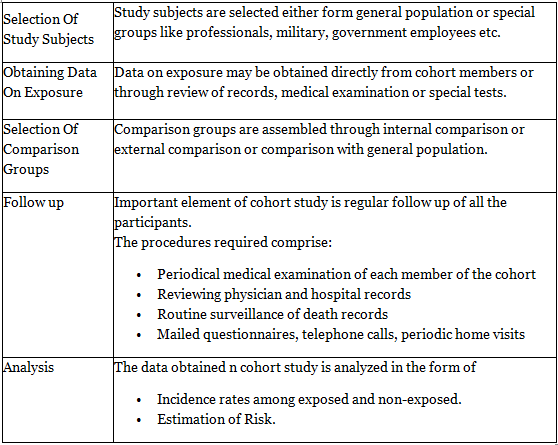
Advantages and Disadvantages
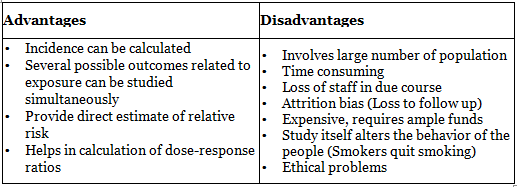
Difference between case control and cohort study
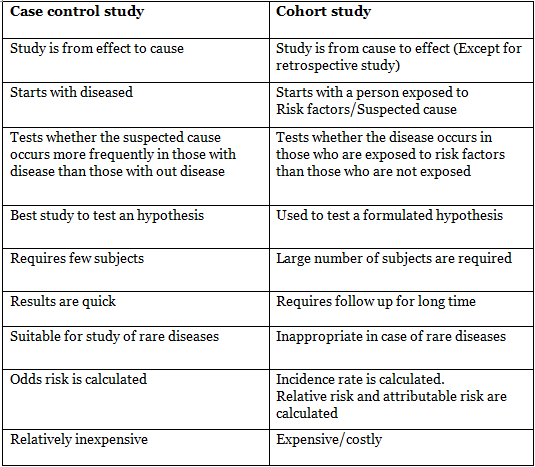
|
7 videos|219 docs
|
FAQs on Cohort Study - Medical Science Optional Notes for UPSC
| 1. What is a cohort study? |  |
| 2. What are the types of cohort studies? |  |
| 3. What are the steps involved in conducting a cohort study? |  |
| 4. What are the advantages of conducting a cohort study? |  |
| 5. What are the limitations of cohort studies? |  |





















